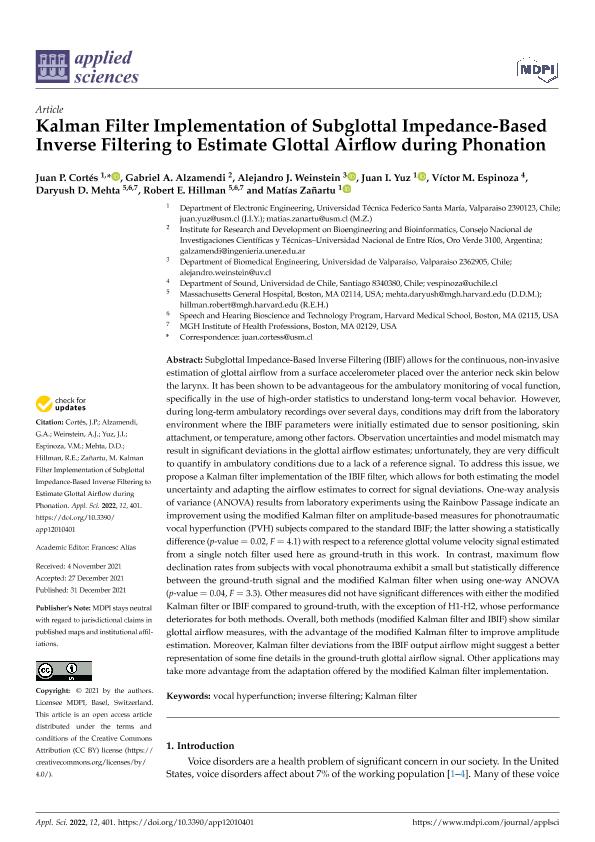Artículo
Kalman Filter Implementation of Subglottal Impedance-Based Inverse Filtering to Estimate Glottal Airflow during Phonation
Cortés, Juan P.; Alzamendi, Gabriel Alejandro ; Weinstein, Alejandro J.; Yuz, Juan I.; Espinoza, Víctor M.; Mehta, Daryush D.; Hillman, Robert E.; Zañartu, Matías
; Weinstein, Alejandro J.; Yuz, Juan I.; Espinoza, Víctor M.; Mehta, Daryush D.; Hillman, Robert E.; Zañartu, Matías
 ; Weinstein, Alejandro J.; Yuz, Juan I.; Espinoza, Víctor M.; Mehta, Daryush D.; Hillman, Robert E.; Zañartu, Matías
; Weinstein, Alejandro J.; Yuz, Juan I.; Espinoza, Víctor M.; Mehta, Daryush D.; Hillman, Robert E.; Zañartu, Matías
Fecha de publicación:
01/2022
Editorial:
MDPI
Revista:
Applied Sciences (Switzerland)
ISSN:
2076-3417
Idioma:
Inglés
Tipo de recurso:
Artículo publicado
Clasificación temática:
Resumen
Subglottal Impedance-Based Inverse Filtering (IBIF) allows for the continuous, non-invasive estimation of glottal airflow from a surface accelerometer placed over the anterior neck skin below the larynx. It has been shown to be advantageous for the ambulatory monitoring of vocal function, specifically in the use of high-order statistics to understand long-term vocal behavior. However, during long-term ambulatory recordings over several days, conditions may drift from the laboratory environment where the IBIF parameters were initially estimated due to sensor positioning, skin attachment, or temperature, among other factors. Observation uncertainties and model mismatch may result in significant deviations in the glottal airflow estimates; unfortunately, they are very difficult to quantify in ambulatory conditions due to a lack of a reference signal. To address this issue, we propose a Kalman filter implementation of the IBIF filter, which allows for both estimating the model uncertainty and adapting the airflow estimates to correct for signal deviations. One-way analysis of variance (ANOVA) results from laboratory experiments using the Rainbow Passage indicate an improvement using the modified Kalman filter on amplitude-based measures for phonotraumatic vocal hyperfunction (PVH) subjects compared to the standard IBIF; the latter showing a statistically difference (p-value = 0.02, F = 4.1) with respect to a reference glottal volume velocity signal estimated from a single notch filter used here as ground-truth in this work. In contrast, maximum flow declination rates from subjects with vocal phonotrauma exhibit a small but statistically difference between the ground-truth signal and the modified Kalman filter when using one-way ANOVA (p-value = 0.04, F = 3.3). Other measures did not have significant differences with either the modified Kalman filter or IBIF compared to ground-truth, with the exception of H1-H2, whose performance deteriorates for both methods. Overall, both methods (modified Kalman filter and IBIF) show similar glottal airflow measures, with the advantage of the modified Kalman filter to improve amplitude estimation. Moreover, Kalman filter deviations from the IBIF output airflow might suggest a better representation of some fine details in the ground-truth glottal airflow signal. Other applications may take more advantage from the adaptation offered by the modified Kalman filter implementation.
Palabras clave:
INVERSE FILTERING
,
KALMAN FILTER
,
VOCAL HYPERFUNCTION
Archivos asociados
Licencia
Identificadores
Colecciones
Articulos (IBB)
Articulos de INSTITUTO DE INVESTIGACION Y DESARROLLO EN BIOINGENIERIA Y BIOINFORMATICA
Articulos de INSTITUTO DE INVESTIGACION Y DESARROLLO EN BIOINGENIERIA Y BIOINFORMATICA
Citación
Cortés, Juan P.; Alzamendi, Gabriel Alejandro; Weinstein, Alejandro J.; Yuz, Juan I.; Espinoza, Víctor M.; et al.; Kalman Filter Implementation of Subglottal Impedance-Based Inverse Filtering to Estimate Glottal Airflow during Phonation; MDPI; Applied Sciences (Switzerland); 12; 1; 1-2022; 1-20
Compartir
Altmétricas



